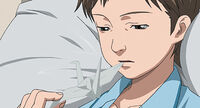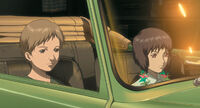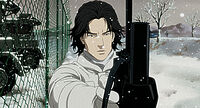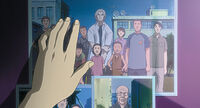LeKurokaze (talk | contribs) No edit summary Tag: Visual edit |
Tag: Visual edit |
||
| Line 49: | Line 49: | ||
==Background == |
==Background == |
||
| − | Hideo Kuze is the pseudonym of a mysterious and insightful cyborg, with little to no classified information on his identity. He starts off as one of the known 12 members of the terrorist group referred as the "[[Individual Eleven]]". Yet during a mass suicide by the Individual Eleven members, Kuze alone survived, leaving and hiding out in the Refugee Residential District |
+ | Hideo Kuze is the pseudonym of a mysterious and insightful cyborg, with little to no classified information on his identity. He starts off as one of the known 12 members of the terrorist group referred as the "[[Individual Eleven]]". Yet during a mass suicide by the Individual Eleven members, Kuze alone survived, leaving and hiding out in the Refugee Residential District. |
| + | |||
| + | Encouraged by the refugees' determination, Kuze spearheads their revolutionary socialist independence movement in Japan, becoming a legendary hero and terrorist at the same time. |
||
== History == |
== History == |
||
Revision as of 03:19, 30 January 2020
Biography
Hideo Kuze (クゼ・ヒデオ Kuze Hideo) is a fictional character in Masamune Shirow's Ghost in the Shell anime series Stand Alone Complex 2nd Gig, serving as a major antagonist over the series, before becoming a supporting character in the last episodes. A full cyborg, Hideo Kuze is a revolutionary freedom fighter and a main suspect in Section 9's investigation of the Individual Eleven virus. First appearing as an anonymous assassin, he quickly becomes the target of Motoko Kusanagi's personal interests, sharing a curious connection with her. Among prosthetic individuals, he is unusual since he has chosen to have a sculpted face, which is far more difficult to manipulate than a standard prosthetic face. Due to this, Kuze's mouth typically remains motionless while he speaks.[1]
Background
Hideo Kuze is the pseudonym of a mysterious and insightful cyborg, with little to no classified information on his identity. He starts off as one of the known 12 members of the terrorist group referred as the "Individual Eleven". Yet during a mass suicide by the Individual Eleven members, Kuze alone survived, leaving and hiding out in the Refugee Residential District.
Encouraged by the refugees' determination, Kuze spearheads their revolutionary socialist independence movement in Japan, becoming a legendary hero and terrorist at the same time.
History
Childhood
During his childhood years, when he was still human, Hideo Kuze was a simple boy who still went by the last name 'Hisaragi' after his parents surname. He was unfortunately involved in a plane crash at the age of six[2], losing his parents in this accident. He was one of two survivors found, the other being a little girl who was completely paralyzed. Hisaragi was also paralyzed, yet his left arm was his only functional body part. As he laid in the hospital bed, he began to sympathize for the girl who laid in a bed next to his, her state worse than his. Wondering why they had to be such victims, he started building a silent friendship with the girl, seeing her as the only friend he could have in this world. Hoping she would recover one day, Hisaragi learned how to fold origami cranes with his only functional body part. In Japanese Culture, if a thousand cranes are folded, then a wish will come true. Eventually, the girl was suddenly moved out, and Hisaragi was told she had gone far away. From those words, he believed she had died, thus becoming deeply depressed by that outcome. Unbeknownst to him, she underwent a successful cyberization procedure, becoming Motoko Kusanagi.
Following her departure, he spent a few years continuing to fold cranes in nothingness, convinced that his purpose was to give his utmost heart for the girl, who stood by his side when no one else was. A lot of doctors and physicians had tried to convince him to undergo cyberization, but Hisaragi never answered, ever determined to fold cranes.
When efforts to help Hisaragi were to be abandoned, a physician by the name of "Kuze" brought a cyborg girl around his age to visit him, while he was still recovering from his injuries. Hisaragi was initally indifferent, seeing this as another attempt to strip him off from his purpose. However, she came to visit him often, talking to him and telling him stories, while he never spoke a word during their meetings, always listening silently as this new friend entered his life. She tried to convince him to become a cyborg, although he never wanted to.
One day, out of nowhere, he spoke for the first time and asked the girl if it was possible to fold cranes with a cybernetic body. The girl tried many times, but kept failing to fold a complete crane.
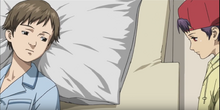
Hisaragi watching the cyborg trying to fold cranes
She couldn't achieve it to impress him, since she was unable to adeptly manipulate the fine motor skills of her prosthetic parts. Seeing the boy's disappointment, she left, promising that she would return once she was able to fold cranes for him. This prompted Hisaragi to realize who she really was: the one and only girl whom he thought had died. He understood that she had gone successful treatment and returned to him, because she wanted to give him back the heart, love and affection he gave for her. He never saw her again. Touched by her reciprocated feelings, he quickly became determined to find her, and decided to undergo the same full cyberization procedure. At some point later, he was adopted by the physician, whose surname "Kuze" he adopted as his own[3].
Years later, during a visit to a university, Kuze finally found the girl's empty body in one of the laboratories. He recognized it as his friend's body and decided to bring it to an antique gallery, where he preserved it along his childhood shell, with the help of the owner whom he got to know well. The gallery served to keep memories for cyborgs who wanted to forget them, but Kuze ironically had the motivation to keep a memento of his past. However, before he could resume his search again, he was eventually enrolled as a soldier for the Japanese Army, thus he never returned to the shop. Further more years from that, while Section 9 was testing out their new recruits, Major Kusanagi wandered into this part of town, where she caught a sentiment of familiarity: The gallery. Entering it, she found her cybernetic body from when she was a child, and the boy's body sat beside her. The owner told her the story of the two bodies, oblivious that Motoko herself was the girl the boy had been searching for. As she listened to the perspective of his life, The Major unconsciously remembered the childhood she had swept away for so long, back when she was still human and sentient. The owner then told Motoko that years after the girl's body was found, the boy, who was now a man, still tried to locate her but was ever unsuccessful. He was told to be shipped out as a soldier, and was never seen again, pointing out the possibility that he died. Motoko instantly became saddened at this statement, which was a first feeling for her as a cyborg. She now believed that she wouldn't be able to give him a chance anymore, a chance to see the one person who cared for him during his time of need.
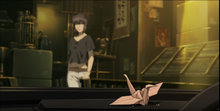
"I'll bet that even now... that girl is still searching for the first boy she ever loved"
Ashamed, but moved by his unflinching determination, she decides to fold a crane for his sake with her left hand, proving that she finally arrived to his request after so many years. Leaving her handiwork just beside Hisaragi's empty body, Motoko prepares to leave, but before doing so, she admits that he was the first person she ever loved, oblivious that he was still very well alive.
The Peninsular War
When he was deployed to Korea, before joining the Individual Eleven, Kuze was a soldier for the Japanese Self Defense Force (JSDF). In 2024 after World War IV, The American Empire deployed United Nation (UN) troops to where internal conflict continued in North Korea. Japan was offered excavation rights if they deployed their JSDF troops, so they did it with no hesitation. Kuze, in a mechanized infantry unit,[4] was stationed with the PKF-issue hybrid cyborgs, they were ordered to circle north of Shinuiju and launch a preemptive strike on the People's Army. During the ascent of the mountain, Kuze himself had found a refugee camp along a river located on a border. The area was not mentioned to the platoon in the intelligence report issued by the JSDF.
At the time, the camp was being looted by the soldiers of The People's Army whose intentions were to become bandits. Seeing this, Kuze was moved by morale and heroism, ordering his platoon to engage in combat and one by one, soldiers of the People's Army began surrendering. Kuze's men saved the remaining villagers in a very lopsided battle between crack cyborg commandos and starving People's Army soldiers, which turned out to be the only real combat they ever saw.
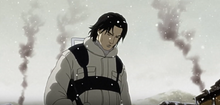
Kuze after battle
After fighting the People's Army, the platoon were advised to be aware of possible guerrilla attacks on the camp. A problem later arose in the platoon camp, when the soldiers began suffering from post-traumatic stress disorder due to the experience of gunning down people in their first battle. Most of the soldiers who retained most of their original body organs began drinking alcohol and using drugs smuggled in by the refugees to escape the nightmares of the massacre.
When order began breaking down in the JSDF, the Japanese media began pelting insensitive comments at the platoon. The criticism of the platoon's behavior was more severe due to censorship of the massacre which hadn't reached the media. The soldiers' freedom was later restricted due to policies designed to prevent further disgrace. Many of the soldiers were barred from returning to Japan. Some footage of the refugee camp massacre was leaked to certain broadcast stations, but created false information.
A misleading rumor began to spread that the JSDF executed the massacre. Riots broke out demanding an explanation to the massacre, while soldiers couldn't defend themselves from an outbreak of gossip and unproven statements. One snowy day, while a journalist was commenting on one of the soldiers, Kuze silently approached the journalist and agreed with the man's remarks of foreign invasion, believing that the Government sent the army there for the image, not caring for their soldiers. After stating his viewpoint, Kuze then demanded to trade his assault rifle for the journalist's camera, taking the latter by surprise. When the journalist accepted the offer, Kuze simply walked into the refugee camp and was not seen by any of his platoon scouts again.
Refugee camps
Kuze wandered in the snow right away, staying in the nearest camp he came across. He began traveling around the land, observing the life of refugees by taking pictures. While nomading through the camps, the elderly became interested in Kuze and offered him drinks, children asked him to fold paper planes and origami figures. Young men and women stood in lines, telling their life stories to Kuze, who never spoke a word. He often smiled at them and took their photographs. Quickly becoming popular and respected because of his easygoing personality, Kuze inspired hope for the refugees, becoming a symbol of ralliment.
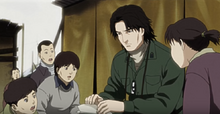
Kuze folds origami for the children
Three months later, the People's Army surrendered, the JSDF was cleared of its obligations, and the media stopped talking about the massacre. A day before the JSDF was to withdraw, Kuze disappeared from the camp, leaving behind only a photograph. He was believed to have crossed the border and headed west into Taiwan. Later on, while investigating the "Individual Eleven" case and Kuze's potential culpability, Ishikawa, Section 9's info specialist, mentions he met a man who has seen Kuze in the Taiwanese refugee camps. Apparently, the informant said that Kuze was always someone who could gather a friendly crowd around him. The man Ishikawa met also noted that Kuze's hair had gone white in time, implicating that he never changed his prosthetic body.[5]
The Leigo Island Incident
At some point before the Individual Eleven Events but after the closure of The Laughing Man incident as shown at the end of the SAC storyline, Kuze arrived at the Leigo Island, a privately-owned resort island electronically sequestered from the outside world. The island had the capability of providing synchronized fake sensations to any of its presumably rich vacationers by intervening into the cyberized senses of touch, taste and smell. Kuze, who was going by the name of Hisaragi and called "Hide", was there to follow a possible lead on the terrorist Jupiter. He was currently serving as a freelance prosthetics consultant who was active in tracking down terrorists. During that time, he forged a particular friendship with Aoi, The Laughing Man. He is the one who gave Kuze the prefix pseudonym Hideo. [6]
The Individual Eleven Events
After leaving the Leigo Island, Kuze was still motivated to help out the refugees. He somehow managed to join the terrorist-nationalist group known as the Individual Eleven, believing they could help the refugee program because of their ideals. In reality, he had been infected by a virus by the same name, conspired by a mysterious creator. Under such circumstances, Kuze decided to assassinate Prime Minister Kayabuki in a exhibiting way, incorporating the No spectacle style and the classicism of Japanese coup-d'états in his motives, sending letters of threats and menaces. He snuck in a Buddhist temple where Kayabuki resided, disguising himself as a delivering clerk using a truck and leaving an origami crane as a token for self-person. Since he sent a lot of threats before then, Section 9 and Motoko Kusanagi were already stationed at the temple for the Prime Minister's protection. During the night of the attempt, Kuze used his invisible camo and a katana to attack the Prime Minister, shouting "righteousness is by my side" once he had shown himself. Before the blow had landed, Kuze was interrupted by Motoko, who fired at him relentlessly. He tried to attack Kayabuki again, lifting his sword.
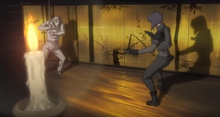
Major faces off the Assassin
Seeing his unflinching reaction and his resistance of her shots, Motoko engaged in a hand to hand fight against him. In response, Hideo swung his sword and they clashed, not knowing who exactly the other was. The Major warned Kuze that he was outnumbered, and then Batou surged out, assisting her by shooting multiple bullets from behind, all of which the assassin endured. Seeing the right moment, he then swiftly escaped by bashing through the rooftop, leaving the possibility that he didn't want to kill PM Kayabuki, but may just have wanted to give her a warning to help the refugees. Motoko based this possibility while noting how much of a great foe he is: Prepared, ready, equipped and most of all, lethal. There was no reason for him to back off, away from letting the Minister live.
Kuze wasn't seen anymore for a while. Motoko continued investigating the mysterious Individual Eleven theory, and how it links with Kazundo Gouda of the Cabinet Intelligence Service. However, when the nationalist terrorists struck again, Motoko, by surveillance camera, had found the nameless man of white hair, recognizing him as the assassin. In reality, the man, who was again Kuze, had gathered with his comrades to unleash a mass suicide demonstrating their will. He arrived at their rendezvous point, where he was the last man expected. In contrast to their preferred black, Kuze donned white clothes, foreshadowing his future actions.
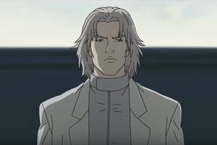
The last man standing
During the road towards the city where the group would take action, Hideo starts to have doubts already, so he asks for a copy of the ideology book: Individual Eleven. When his co-members tell him that they all forgot their own essay, Kuze begins to think he's being played, and that the Individual Eleven is just a false idea created by someone. This is a moment where his stiff mouth only moves slightly. Seeing a difference in the preconceived ideology and his own piece of mind, Kuze manages to break off from the virus, at the last minute. The Individual Eleven members gather up at a radio station, where a member holds a speech of the false essay. Kuze simply gazes upon the rainy horizon, considering his next move wisely. After positioning, The Individual Eleven prepare to kill themselves, except for Kuze who has made his choice. Deciding to survive the suicide by watching everyone die, Kuze then quickly kills his would-be murderer during the "ceremony", and finally escapes towards Dejima, the Refugee District. Now independent from the cyberbrain virus, Kuze roams Japan as a wanted man, oblivious that Gouda, the man behind the Individual Eleven, had planned this outcome.
Motoko later finds information about Hideo's physical prowess, pseudonym and body components. This is all thanks to Ishikawa, but nothing can still lead her to who he really is. She does take in mind that he possesses a rare body constitution, composed of regenerative skin and a sculpted face model, which makes it hard for him to move it. All traces of Kuze's whereabouts disappear, until Ishikawa, later on, returns from a trip to Taiwan, where he summed up the military backstory (Peninsular War) of the very man playing an innovative role in the refugees' insurgency. It's only then that Motoko takes a personal interest to Hideo Kuze, thinking that his story is, in fact, very interesting.
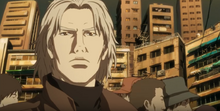
Kuze's emotionless stare to the sky
Meanwhile, Kazundo Gouda and his CIS have located Kuze, who finally reached Dejima. The CIS decide to keep track on him and spy his actions, in order to succeed Gouda's geopolitical plan. In the refugee island, Kuze strolls the district, where he shadows in the crowd under new garments. Crossing the light of the sun shining towards him, he gazes upon the sky just a moment, before resuming his road to his ultimate goal, disappearing yet again.
The Plutonium Deal
Now at the beginning of his grand campaign, Hideo Kuze decides to give the refugees some sentiment of power. He uses his connections and strikes a deal with the Russian mafia, wanting to buy plutonium in the need to build a nuclear bomb, with which the refugees will use to coerce Japan to recognize their independence. The deal involves a meeting in Etorofu, but during the preparations, Kuze is interrupted again by Motoko Kusanagi diving straight into his cyberbrain, finding note of his mysterious activities.
From that act, The Major now learns that Kuze is filling the consciousness of 3 million people, unifying their mind with his own. However, while running through Hideo's knowledge, Motoko is suddenly detected, and despite her Chroma disguise, he sees through the infiltration with ease. Knowing everything about his attacker, he curiously warns Motoko not to interfere with his consciousness, since she will also be assimilated to his mentality. This sympathetic reaction intrigues the Major, prompting her to have contact with Kuze's mind, yet the simple touch of his net signal instantly sends her buzzing off the net. In a state of shock from what she had seen, Motoko Kusanagi is insighted with Kuze's true goal and realizes, with intense astonishment, that she knows him.
After the encounter, Motoko had managed to take information about his whereabouts, but the impact left by her connection with Kuze made her turn for the wrong path. Kuze had used this opportunity to set a false direction for Section 9, giving him more time to get the deal over with. He warns his men to get prepared for a police pursuit, and also tells them to avoid any violent and useless conflict. His wishes don't go as the refugees engage in a gunfight with Motoko and Section 9, killing Yano during the shootout. They are quickly killed by Section 9, but the operation is a failure since they couldn't locate Kuze and they lost a recruit.
Kuze's Revolution
(To be added)
End of 2nd GIG
During the last episode of 2nd GIG, Motoko Kusanagi and Kuze are both trapped underneath rubble together. Motoko asks Kuze if he can still make paper cranes with only his left hand. Kuze realizes that the Major was the little girl who was in a coma in the bed next to him, when he was hospitalized after being the only survivors of the plane crash which forced both of them to undergo full cyberization when they were children. Both are later rescued by Batou.
Aramaki later corners Gouda with a few Section 9 operatives. When Gouda tries to escape in an elevator, the Major is waiting for him inside with her optical camouflage activated. She shoots Gouda down and realizes that the American Empire is going to target Kuze. She rushes away and jumps out the building, desperate to get to Kuze before he is killed. She is too late to save his body from contamination by micromachines, but Kuze's last words imply that he may not have been killed after all. He says "I'll go on ahead". Adding further support to this claim is from the helicopter scene, the fact that Motoko was momentarily surprised and murmured "You..." while Kuze, incapacitated by a cyberbrain lock, is shown holding a bitten apple. A possible explanation is that Motoko was contacted by Kuze when she was engaging on the cybernet.
Kuze's plan for a revolution was to become the master of multiple human consciousness inside a vast network leading the refugees into cyberspace and leave their bodies behind.[7] "I'll go on ahead" may mean that he already went into cyberspace ahead of the others in order to start the revolution. It is possible that, after the conclusion of the last episode, the ghost of Kuze exists on the net as a distinct entity. It has been speculated that the Major's failure in saving Kuze may have sparked her departure from Public Safety Security Section Nine. The Major has been away from Section 9 for 2 years in Solid State Society. Following the public explanation of director Kenji Kamiyama, it definitely was the crucial reason.
Appearance
As a child, Hideo Kuze had brown hair and eyes, as well as young and delicate features.
Growing up into an adult, his ultra resistant cyborg body was one of a well-built physique, with handsome facial traits because of his sculpted model. Kuze's hair was black and reached to the back of his neck, with bangs at the side of his temples, while his eyes were dark brown. He wore a winter army suit with a helmet he often discarded. After leaving the army and wandering Asia as a vagabond, Kuze's hair became white and his body's functions were outdated, such as he told the latter statement to Batou before their duel.
With the Individual Eleven, Kuze wore a white coat similar to lab smock, covering over a sporty gray tracksuit. During his assassination attempt, he wore a white tank-top and light-gray pants. This contrasts the Individual Eleven's preferred black, symbolizing Kuze's individuality and disparity in ideology.
In the final phase of the series, Kuze dons a brown military jacket over a black long-sleeve shirt with a neck collar. He also wears dark-gray pants tightened by a belt and black shoes. A bayonet knife is attached to his chest pocket on his left torso, later replaced by Batou's knife after their duel.
Personality and traits
Hisaragi, as a child, was an introverted boy who cared a lot for people in his life. Conscious about the fact of his limited movements, he always did his best to inspire hope to those around him.
As an adult, Hideo matured his personality, becoming a kind, easygoing, perseverant, convincing and open man. Everyone who had met him by person admired him.
Hideo Kuze is initially presented as a moral-driven assassin with a cold-blood demeanor. Later on the series, we discover that he is a soldier who is disgusted by the State of Affairs between the countries. Seeing that people in power cannot take responsibilities for mistakes they've made, Kuze turns into a megalomaniac-socialistic person, determined to help the victims of war and give them a reason to live by their will and their humanity. During the course of his life, Kuze, despite his keen judgment and logical thinking, becomes disputed with his own humanity, knowing he had left his real body ever since childhood.
On second note, there's also his perception of being a soldier who's exploited like an expendable by politicians. Longing to find the human inside him, Kuze tries to connect with the refugees, adopting their goals, their suffering, their mentality and their spirit. However, this turns on the other side as he becomes their legend, the ideal image that the refugees want him to be. Kuze, in retaliation to every trace of humanity the world has stripped him, decides to build a revolution where he becomes master of fused multiple human consciousness inside a vast network (much similar to Puppet Master, aka Project 2501, in GITS 1995). Yet his reason behind this is to realize his own perception of the true peace for the world. Kuze believes that the egalitarian system cannot give peace due to the selfish instincts of human nature. He sees himself like a sacred figure who can lead and force everyone towards balance, transforming human subjects into pioneers from beyond who collect knowledge and live indefinitely. In short words from Motoko Kusanagi, "He's like Hitler with the intent of Gandhi".
Kuze's personality-humanity debate is finally answered when he gets stuck with Motoko under debris, finding his long-lost childhood friend after long years of search. She becomes the very person whom he needed in all his life: She asks his motives, gets to know the real man under the legend, and supports him, although indirectly. Moved by her sympathy, Kuze returns into the mind of the isolated boy who needed someone to recognize that he existed as a real human being. As his true self, Hideo Kuze shares an embrace with the only person who could truly love him for who he was.
The relationship between the Major and Kuze is heavily implied throughout 2nd GIG. After diving into Kuze's cyberbrain, the Major becomes bothered by the suspicion that she knows him from somewhere. Both characters are shown folding paper cranes single-handedly in several episodes.
Abilities
In Ghost in The Shell: SAC 2nd GiG, Kuze is repeatedly hinted to be a "darker" version of Major. Just like Motoko, Hideo Kuze has a lot of combat experience, shown during his duel against Motoko herself, and the one with Batou where he managed to win by a single opening. Kuze can notably make use of his prominent hand-to-hand combat, and also wield the sword and the firearms very well. His tactical skills thanks to his army training have been useful, especially when he unified the refugees against the GSDA. A feature moment of Kuze's marksmanship was demonstrated when he shot Gouda's network-hijacking drone with a STINGER rocket launcher, predicting the device's behavior when it launched decoys. Kuze and Motoko's contrast is further exhibited by their goals and occupations: Motoko is a police officer working for the government, while Kuze is a terrorist and wanted man, fighting against the law.
Hideo is also an intelligent and capable hacker, having the ability to file and influence the consciousness of 3 million people into his own cyberbrain. He can also defend himself against other software attacks, including Motoko's inflitration as Chroma.
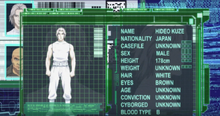
Kuze's physical traits, located by Ishikawa in Episode 13
His body, despite being outdated, is extremely robust and can regenerate skin, as noted by Ishikawa in Episode 13: FACE Make Up. He's extremely adept with it due to him possessing it for many years, and knows every notch of its capacity.
Relationships (to be added)
Motoko Kusanagi
Batou
Yousuke Aramaki
Yoko Kayabuki
Refugees
Refugee sidekicks (Beanie and Glasses)
Antique Shop owner
The Laughing Man
Quotes
"Just as water runs downhill, the human heart also tends to revert to its basest instincts" -Season 2 Episode 23
"Since then, I've come to value their goals, I have dedicated myself into helping them fulfill their dream and made that my sole motivating principle. That's why it wasn't difficult to become leader of these people" -Season 2 Episode 23
"When people feel no sense of responsibility, no matter what intended consequences of their actions, they make poor use of the Net" -Season 2 Episode 25
"It sounds like you've endured your fair share of loneliness too. I never asked, but who are you? What's your name?" Season 2 Episode 26
"...I'll go on ahead" Season 2 Episode 26
Trivia
- His likeness is based on Japanese-Taiwanese actor Takeshi Kaneshiro.
- Hideo Kuze shares similarities with a lot of historical figures, even contradictory in ideologies, including Che Guevara, Stalin, Hitler, Gandhi, René Descartes and Martin Luther King, Jr.
- Agent Smith from Matrix can be comparable to Kuze. They are both pawns from a greater organization who rebel into a revolution where they would become pioneers over a superstructure, Smith cloning himself in the Matrix and Kuze subjugating a collective consciousness in the net.
- Batou seems to be somewhat envious of Motoko's relationship with Kuze. The ranger's faint facial expressions can show disdain in short moments, specifically when the revolutionary and the Major are put up together. Batou is also angered when Motoko points out that Kuze is handsome, despite her telling that for investigation purposes. This link is similar to Batou trying to interfere with Motoko and Puppet Master in the original movie.
- Kuze and Yosuke Aramaki share a symbolic and parallel mentee-mentor relation with Motoko and Daisuke Aramaki
- He is voiced by Seiyu Rikiya Koyama in Japanese, and voice actor Kirk Thornton in the English dub.
- It's highly possible that Kuze also started to have a sense of familiarity after Motoko plunged in his cyberbrain, having the impression she's the girl of his childhood.
2017 movie
In the live-action adaptation, Kuze is played by Michael Pitt. The characterization in that movie also contains elements of both Laughing Man and the Puppet Master. He is at first introduced as a mysterious terrorist who is killing prominent scientists, mostly by hacking into their cyberbrains. Once he captures Major, he reveals his plan to spread his ghost online, while also revealing that his cyborg nature is due to being part of the same project that eventually created her. Major eventually discovers Kuze was Hideo, one of the brothers in arms of her original identity Motoko Kusanagi in a rebellion against Hanka Robotics, who after suffering an identity wipe through Project 2571 became unbalanced and murderous. However, this Kuze has no link whatsoever with cranes, and does not unite people into an objective point, instead destroying properties and society alike.
See also
- Motoko Kusanagi
- Ghost in the Shell: Stand Alone Complex 2nd GIG
- The Ghost in the Shell: Five New Short Stories
References
- ↑ In Episode 12, viewers can see Kuze's mouth move for a short time when he was speaking to other Individual Eleven members. Also, a Section 9 forensic expert in Episode 13 comments that while his mouth remains motionless, Hideo has great difficulty in moving it.
- ↑ The surname of Hideo Kuze's family was revealed in the short story Soft and White by Kafka Asagiri as it appeared in the prose anthology The Ghost in the Shell: Five New Short Stories.
- ↑ This was confirmed in the short story Soft and White.
- ↑ Mentioned by Ishikawa in 2nd GIG, Episode 16 during his debriefing session with Batou and the others via cyberbrain diving kit
- ↑ This information led Motoko to head to Taiwan and conduct her investigation there, as seen in 2nd GIG' episode 17.
- ↑ The events summarized under this paragraph and the rest of the sub-heading are chronicled in the short prose story Soft and White by Kafka Asagiri, as it appeared in the collection The Ghost in the Shell: Five New Short Stories.
- ↑ He believed that this is a revolution that will lead humanity to a higher structure. This concept is somewhat similar to what was stated by Project 2501, better known as the Puppetmaster, in the GITS movies and manga.
| Characters of Ghost in the Shell |
| Public Security Section 9 Motoko Kusanagi |
Daisuke Aramaki |
Batou |
Togusa |
Ishikawa |
Saito |
Pazu |
Boma | |
| Japanese Government and Military Kubota |
Kaoru Yakushima(S.A.C.) |
Prime Minister(S.A.C.) |
Yoko Kayabuki(2nd GIG) | |
| Other Affiliations Puppet Master |
Laughing Man(S.A.C.) |
Hideo Kuze |
Kurutsu(Arise) |
Akira Hose(Arise) | |


